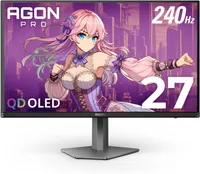Get the most affordable OLED gaming monitor for $399 at Amazon before it's too late — The 27-inch 240 Hz AOC Agon Pro is now at its lowest price ever

Are you tired of your IPS monitor's dull colors and backlight bleed? This Black Friday, look at the most affordable OLED monitor—the AOC Agon PRO 27-inch, which is available for a historic low of just $399. Long gone are the days when you'd have to spend $1000 or even more to get a decent viewing experience.
The AOC Agon PRO lineup has many flavors, but we're looking at the 27-inch OLED QHD version. The monitor offers a 2.5K resolution (2560x1440) running at 240 Hz, supporting HDR10 while promising 101% DCI-P3 and 136.7% sRGB coverage. It is FreeSync and G-Sync compatible, so you won't have to deal with screen tearing.
Get the most affordable OLED monitor at Amazon for $399, as the AOC Agon Pro 27-inch 240 Hz is at a historic low.
The viewing angles hold up pretty well at 170 degrees, though they fall slightly short of other, more expensive offerings. Likewise, its OLED design offers a near-infinite contrast ratio and an impressive 0.03ms GTG response time. However, per our extensive testing, it does underperform in the HDR brightness department, which we suggest you go over if you plan on purchasing this monitor.
Regarding connectivity, the AOC Agon Pro 27-inch features two HDMI 1.4 ports, two DisplayPort 1.4 ports, two USB Type-A 3.2 ports, one USB Type-B port, and a 3.5mm audio jack. As of this writing, the AOC Agon Pro is the most inexpensive OLED monitor at Amazon, making it an absolute steal if you're in the market for an upgrade.
Head to the official Amazon page to snag this monitor before inventory runs out.
We are working hard to find the best deals for you this Black Friday. If you're looking for other products, check out our Black Friday Computer Hardware Deals Live blog for a range of products, or dive deeper into our specialized SSD and Storage Deals Live blog, Monitor Deals Live, Graphics Card Deals, or CPU Deals pages.
Get Tom's Hardware's best news and in-depth reviews, straight to your inbox.

Hassam Nasir is a die-hard hardware enthusiast with years of experience as a tech editor and writer, focusing on detailed CPU comparisons and general hardware news. When he’s not working, you’ll find him bending tubes for his ever-evolving custom water-loop gaming rig or benchmarking the latest CPUs and GPUs just for fun.
-
Roland Of Gilead Reply
This is a particular bug bear of mine! QLED/Mini Led is better than OLED (for the most part) in terms of brightness. HDR10 implies a maximum brightness of 1000nits. 250nits is pants, even for entry level IPS panels.hotaru251 said:how the heck does this claim HDR10?
Its a 250nit display.... -
thestryker Reply
This doesn't mean what you think it does with regards to HDR. This display can reach up to 1000 nits at 3% screen area and 450 nits at 10%. OLED displays due to their nature do not have high full screen brightness so from that aspect will always be beaten by prior technologies.hotaru251 said:how the heck does this claim HDR10?
Its a 250nit display.... -
Roland Of Gilead Reply
Oh, that's interesting. I've seen this kinda thing in reviews, and admittedly didn't really try understand it in any great detail. But looking into it, I see how it works now.thestryker said:This doesn't mean what you think it does with regards to HDR. This display can reach up to 1000 nits at 3% screen area and 450 nits at 10%. OLED displays due to their nature do not have high full screen brightness so from that aspect will always be beaten by prior technologies.
So, for example if there is a scene in a movie, where lets say there is a single bright bulb in a room - that bright thing (light) may only occupy 3% (or whatever precent) of the screen space and so the screen could give that bright spot the full 1000nits or whatever, and then it's a descending scale, based on the size/proportion of the screen that the bright part occupies. Is that it? -
thestryker Reply
Yeah that's pretty much it. The metadata within the source dictates how everything should be lit up.Roland Of Gilead said:Oh, that's interesting. I've seen this kinda thing in reviews, and admittedly didn't really try understand it in any great detail. But looking into it, I see how it works now.
So, for example if there is a scene in a movie, where lets say there is a single bright bulb in a room - that bright thing (light) may only occupy 3% (or whatever precent) of the screen space and so the screen could give that bright spot the full 1000nits or whatever, and then it's a descending scale, based on the size/proportion of the screen that the bright part occupies. Is that it?
When I got a TV with proper HDR it was a bit jarring at first when my room was dark because when direct light sources were on the screen in a relatively dark scene it would light up my room.
